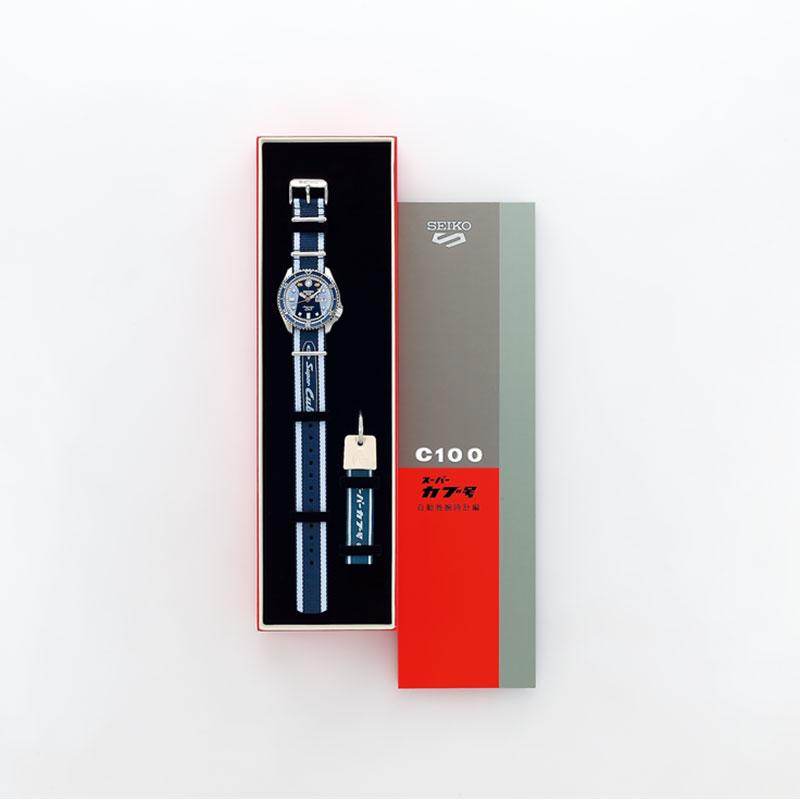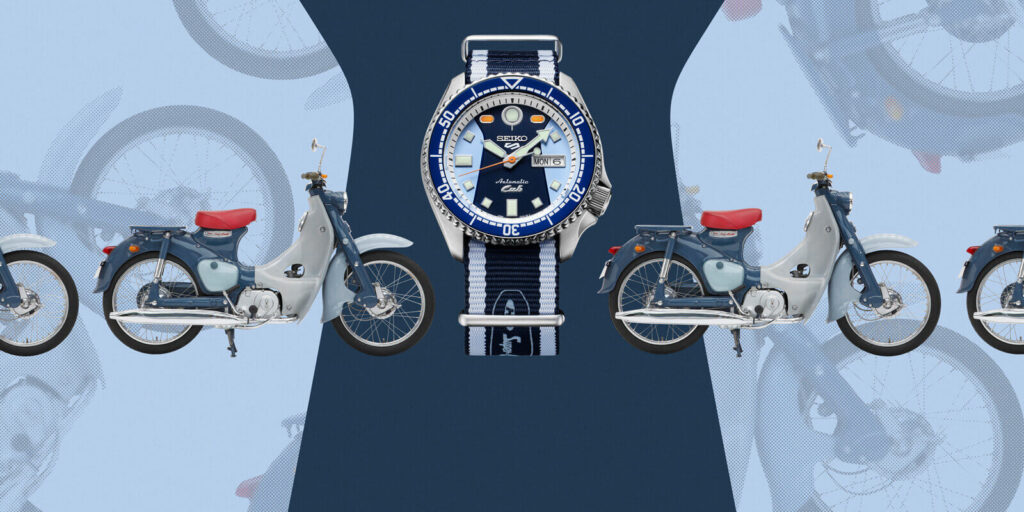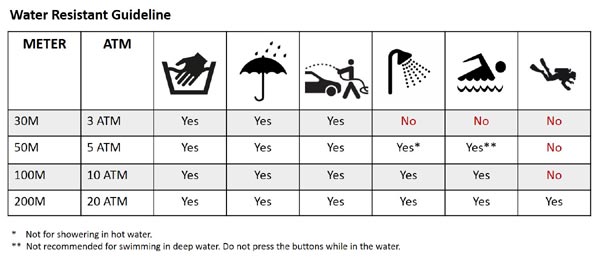Description
SEIKO 5 Sports SRPK37 Specifications
| Features |
| |||
|---|---|---|---|---|
| Driving system | Automatic with manual winding | |||
| Caliber number | 4R36 | |||
| Case material | Stainless steel | |||
| Case back | See-through screw with Honda Super Cub emblem | |||
| Case color | Silver tone | |||
| Band type | Strap | |||
| Band material | Nylon NATO-style incorporates the Super Cub logo and the initial Honda logo | |||
| Band color | Light and dark blue | |||
| Band width | 22 mm | |||
| Clasp | Buckle | |||
| Dial color | Light and dark blue with the silhouette capture of the Super Cub as seen from the front | |||
| Glass material | Hardlex | |||
| Hands | Luminous grey and silver tone (hour, minute) with grey, silver tone and orange second hand | |||
| Dial markers | Grey and silver tone batons indexes with round index at 12 o’clock that represents the headlights while orange dots indexes at 11 and 1 o’clock indices suggest the blinkers | |||
| Second markers | Minutes markers around the outer rim | |||
| Lumi Brite | Hands, indexes and bezel | |||
| Bezel | Unidirectional rotating dark blue colored with silver tone arabic numerals per 10 minutes scale and triangle index at 12 o’clock position | |||
| Crown | Push-pull out at 4 o’clock position with wing mark on the first-generation Super Cub | |||
| Calendar | Day and date display at the 3 o’clock position | |||
| Function | Day, date, hour, minute, second, stop seconds hand | |||
| Drive duration | Power reserve approximately 41 hours | |||
| Magnetic resistance | 4,800 A/m | |||
| Water resistance | 10 bar water resistance (100 meters / 330 feet) | |||
| Vibrations | 21,600 vibrations per hour (6 beats per second) | |||
| Size | Diameter 42.5 mm x Thickness 13.4 mm | |||
| Lug to lug | 46 mm | |||
| Bracelet length | 220 mm | |||
| Weight | 95 g |
SEIKO 5 Sports SRPK37 Features
Seiko 5 Sports 55th Anniversary Super Cub Limited Editions
Seiko 5 Sports introduces a new creation inspired by the Super Cub, one of the world’s most-produced motorcycles of all time.
This special limited-edition watch expresses the first-generation Super Cub’s design from 1958 in every detail.
Super Cub
Favored by motorcycle fans worldwide, the Super Cub was introduced in 1958 and has since become one of Honda’s most representative creations. In 2017, the cumulative production of the series exceeded 100 million units.
Dial & Index
The dial captures the Super Cub silhouette as seen from the front, with the indexes representing the headlights and blinkers.
Crown
The wing mark on the first-generation
Super Cub adorns the crown.
Strap
The nylon strap incorporates the Super Cub logo and the initial Honda logo.
Case back
The collaboration is offered as a limited edition with the Super Cub emblem on the case back along with the words “LIMITED EDITION” and the individual serial number ranging from 0001/7500 to 7500/7500.
*Item may differ in appearance from the image shown
Special Box
The watch will be sold with a special strap and will come in a box whose vintage styling is reminiscent of the first Super Cub instruction manual.
- Calendar day and date display
- LIMITED EDITION on the case back
- Serial number engraved on the case back
- See-through and screw case back
- Unidirectional rotating bezel
- 24 jewels
- Stop seconds hand function
About Seiko 5
Seiko 5. Bold designs that speak volumes about those who dare to wear the Seiko 5. The inspiration lies in the edgy designs and dramatic colours, that come together with an innovative automatic movement that defines the very spirit of a Seiko 5.
From the very start, Seiko 5 was a watch whose performance would serve the demanding needs of the new 1960’s generation, who cared less for tradition and more about life. The watch had five key attributes :
1. Automatic winding
2. Day/date displayed in a single window
3. Water resistance
4. Recessed crown at the 4 o’clock position
5. Durable case and bracelet
The technology behind the legend
From the start, Seiko 5 was designed to break the mold of watch performance and to bring to the young 1960’s generation a watch that belonged to their age and that fitted into their lives. As perhaps never before, young people of the day saw no limits to their aspirations. Seiko 5 needed to be a watch that could go anywhere and everywhere. The first challenge was durability. To be durable, a watch needs to be impervious to two threats; water and shock.
Water resistance was built in as standard to every Seiko 5 watch, and metal bracelets were used so that, from buckle to buckle, the watch was resistant to water and sweat. Shock resistance was assured with two Seiko inventions. First, the mainspring was made from “Diaflex,” an unbreakable alloy, and the “Diashock,” system was created to protect the movement from shock within the case.
Legibility was the next vital attribute. Today, we take for granted that day and date are presented in a single window but, in fact, this was an idea built in to Seiko 5 to enhance the legibility of the dial. The genius create a unique system that allowed both day and date to be shown in one plane.
The final challenge was to create a distinctive look that defined the brand. Thanks to the extraordinary Seiko invention of the ‘Magic Lever,’ the winding efficiency of Seiko 5 is very high, and the wearer rarely needs to use the crown. So the designers made it smaller and hid it under the lip of the case at 4 o’clock, giving Seiko 5 its signature look.
History of Seiko 5
Seiko began producing its Seiko 5 line of automatic watches back in 1963. Since then watch enthusiasts around the world have come to recognize Seiko 5 as reliable, affordable and well respected watches. Over the last 50 years Seiko has produced thousands of different models in the line.
History of Seiko
The company was founded in 1881, when Kintarō Hattori opened a watch and jewerly shop called “K. Hattori” (服部時計店 Hattori Tokeiten) in the Ginza area of Tokyo, Japan. Eleven years later, in 1892, he began to produce clocks under the name Seikosha, meaning roughly “House of Exquisite Workmanship”.
The first watches produced under the Seiko brand appeared in 1924. In 1969, Seiko introduced the Astron, the world’s first production quartz watch, it cost the same as a medium-sized car. Seiko later went on to introduce the first quartz chronograph.


























